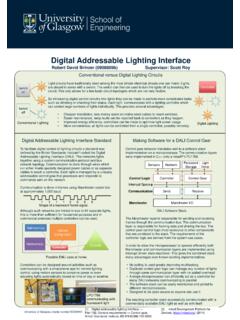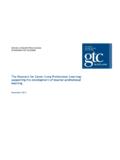Transcription of Constructability of Embedded Steel Plates in Cast-in-Place ...
1 Constructability of Embedded Steel Plates in Cast-in-Place Concrete Best practices for design, fabrication, coordination, and construction by James Klinger, Frank Salzano, Tim Manherz, and Bruce A. Suprenant E. mbedded Steel Plates with headed studs (embeds) serve as connections to structural Steel framing, fa ade and curtain wall systems, elevator rails, Steel or precast stairs, mechanical-electrical-plumbing components, and miscellaneous additional items. Proper anchorage and Exposed connection to concrete must be given a high priority by the to entire design and construction team. weather Concrete cover? As members of the American Society of Concrete Concrete cover? Contractors (ASCC), we met in May 2018 to share experiences on the topic of embeds. This article presents our recommendations for best practices for design, fabrication, Fig. 1: The structural engineer of record must define the controlling coordination, and construction of Embedded Steel Plates in concrete cover on an embed (based on Reference 4).
2 Cast-in-Place concrete. All recommendations are directed at Constructability (cost, jobsite safety, and schedule issues), not replacement of embeds, using the OSHA3 procedure for the structural capacity of the plate or anchors. SER approval of actions taken on anchor rods; and Design Develop action plans for dealing with misalignment, dislocation, or out-of-tolerance installations of embeds. Chapter 17, Anchoring to Concrete, in ACI 318-141 The SER must also define the controlling concrete cover provides design requirements for anchors in concrete used to along the vertical face exposed to weather on embeds, using a transmit structural loads by tension, shear, or a combination detail in the concrete documents (Fig. 1).4 AISC's Design thereof. The American Institute of Steel Construction (AISC) Guide 22: Fa ade Attachments to Steel -Framed Buildings 5. Design Guide 23: Constructability of Structural Steel addresses the common fa ade attachment for a concrete Buildings 2 provides recommendations for the structural slab- Steel frame building.
3 One of the most economical slab engineer of record (SER) to consider during the design edge details incorporates a 10- to 20-gauge cold-formed metal phase, including: pour stop (edge form) welded to the spandrel beam in the Design embeds for a minimum of 2 in. (50 mm) field, during erection of the metal deck (Fig. 2). eccentricity in each direction, to allow for relocation of the If the overhang carries any fa ade attachment loads, the plate due to reinforcing bar interferences; load path must be directly into the slab and not through the Detail the embed plate to be up to 6 in. (150 mm) wider pour stop itself, as light-gauge metal pour stops rarely have the and taller than designed, to allow for relocation due to bar strength required for fa ade attachments. Furthermore, if Steel interferences; embedment Plates are cast into the slab for fa ade attachment, Completely design embeds and include the necessary only very heavy-gauge pour stops are stiff enough to secure details within the contract documents, especially if the the embedment Plates for positioning in the slab.
4 Reference 5. connections are governed by seismic design provisions; provides design guidelines for slab edge details when attaching Require SER approval of repair, modification, or fa ade elements to bent Plates or other structural Steel . 28 SEPTEMBER 2018 | Ci | Based on discussions at the recent ASCC meeting, we Treating the plate as an opening (terminating affected assembled additional recommendations for the SER: bars and adding splice bars to maintain continuity Detail reinforcing bars at any embed with a plate thickness across the plate dimension); and exceeding the concrete cover minus the clearance required Using a thinner plate, with stiffeners oriented parallel to per Section of ACI 1176 (Fig. 3 and 4). The SER will the outer bars. be in the best position to evaluate the effects such a detail Adjust stud spacing when Plates are used at the edges of will have on structural behavior, while also considering the walls, columns, or slabs.
5 Embed details often indicate that effects it will have on cost and schedule. Options might studs are about 2 in. from the edge of a plate; however, if include: the plate is to be located at an edge, then the first row of Increasing the cover for the entire reinforcing bar curtain; studs will probably conflict with a reinforcing bar (Fig. 5). Providing offset bends in the affected bars (note that this It may also be necessary to consider the effect of a chamfer at a wall or column corner;. may necessitate additional ties);. 2 in. min. mi in. 1/2. n. 1 in. @ 12 in. 2. Clear distance 1 Pour stop Bar Overhang 3. Notes: The pour stop is designed for wet weight of concrete, concrete fluid Clear distance 1. pressure on the vertical leg, and a 20 lb/ft2 load. 2 The slab is designed for self weight and all superimposed loads. Fig. 4: An illustration of the requirements in Section of ACI 117, 3 The overhang is generally less than 12 in.
6 For light-gauge metal pour stops. which specifies that the clearance between Embedded items and the nearest reinforcing bar shall be the greater of the bar diameter, Fig. 2: A typical pour stop detail for a slab on metal deck (based on largest aggregate size, or 1 in. (25 mm). The figure in the associated Reference 5) (Note: 1 in. = 25 mm; 1 lb/ft2 = kN/m2) commentary indicates that the clear distance is a tolerance Fig. 3: Reinforcing bars must clear embed Plates and studs by the clearance provided in Section of ACI 117, and the SER must Fig. 5: A reinforced concrete wall with embeds and penetrations, provide details showing how the clearance is to be maintained. This shown prior to closure of the formwork. The embeds adjacent to the is particularly critical when the embeds have very thick Plates wall penetrations interfere with the vertical bars in the wall (photo courtesy of Bruce Suprenant) (photo courtesy of Bruce Suprenant).
7 | Ci | SEPTEMBER 2018 29. Provide special studrail details when the concrete slopes or reduces in thickness, such as at a balcony. For instance, an 8 in. (200 mm) thick slab may have a 3/4 in. (19 mm). step-down to accommodate a balcony door, and the balcony may slope for drainage. The final slab thickness will then be about 7 in. (175 mm). If stud rails are used to reinforce the balcony, the stud height must be reduced to accommodate the depth change as well as maintain adequate cover for the exterior environment;. Avoid embeds with attachments welded on both sides of the plate, as formwork will need expensive modifications to accommodate the outer attachment and thus may not be reusable. Such embeds are typically more difficult to set within tolerances. The cost-effective option is to weld or anchor attachments to embed Plates after concrete has been placed;. Design embeds at tops of walls and curbs, slabs, and other Fig.
8 6: Embed Plates require small diameter holes for installation on locations so that they do not interfere with concrete wall form (photo courtesy of Ceco Concrete Construction). placement. Consider options such as discontinuous embeds. Also, consider allowing wet-setting embeds in construction manager (the controlling contractor). Concrete accordance with ACI provisions for precast and tilt-up contractors may condition their bids upon the timely delivery construction7; of embeds with Plates predrilled for nailing to forms. Often, Provide direction to the concrete contractor if the perimeter however, the requirement is neglected, and embeds are embeds must be positioned to offset slab shortening due to shipped to the site without predrilling. This causes delays, as post-tensioning; embeds must be shipped back to the fabricator's shop for Indicate whether reinforcing bar clearance next to the plate drilling. The SER should address the issue in the project is important.
9 ACI 117 requires at least 1 in. (25 mm) specifications by requiring predrilling of the Plates . This will clearance between embed Plates and reinforcing bars, to reduce confusion and minimize delays. allow concrete to flow between the bar and plate (Fig. 4); At a minimum, embeds that will be installed on formwork Perform a Constructability review that includes checks for will need erection holes at all four corners of the embed plate interference between embeds and bars or tendons. Be (Fig. 6). Plates exceeding about 24 in. (600 mm) in width particularly careful to avoid locating slab embed Plates require additional holes spaced no more than 18 in. (450 mm). directly above post-tensioning anchors. Also note that the apart to ensure the plate remains in contact with the formwork details may have to be revisited after bidding, for sheathing during concrete placement. Holes should be 3/16 in. coordination with the architect and specialty engineers ( mm) in diameter, to accommodate a 16d nail or a No.
10 8. responsible for post-tensioning and cladding; (4 mm) drywall screw. Holes this size must be drilled they Specify nail and air holes in fabricated items to facilitate are too small to be punched. Constructability (see Fabrication ); One or more larger holes will be necessary for embeds that Specify whether the position of the embed, reinforcing will be set in tops of slabs. In addition to pre-drilled corner bars, or post-tensioning tendons controls when interference holes, embeds larger than 24 in. in both directions placed on occurs; the top of slabs need an air relief hole or sight hole to verify Design fewer standardized embed types; that the concrete flows under the plate (Fig. 7). The air relief Provide an embed schedule for clarity; and hole can be 3/4 in. in diameter and can therefore be punched. Require an embed coordination meeting between the design and construction teams, separate from the concrete Coordination preconstruction meeting (see Coordination ).





